Entrepreneurship Management Report: Analysis of Beewits Digital Agency
VerifiedAdded on 2021/02/22
|21
|4605
|88
Report
AI Summary
This report provides an in-depth analysis of entrepreneurship management, using Beewits, a digital marketing agency, as a case study. It covers the main stages of becoming a successful entrepreneur, emphasizing the importance of a well-defined business plan, and evaluating key characteristics for effective implementation. The report utilizes SWOT analysis to identify strengths, weaknesses, opportunities, and threats, providing strategic recommendations. It further examines niche market evaluation, operational and financial needs, record-keeping frameworks, and job descriptions for attracting the right talent. The report also explores academic models for targeting specific business needs, including the Canvas business model, and discusses product development, marketing strategies, and liquidity plans for business sustainability. Finally, it assesses the impact of research, the role of feasibility studies, and the key tasks of operational, growth, and financial management, offering a comprehensive overview of entrepreneurial practices.
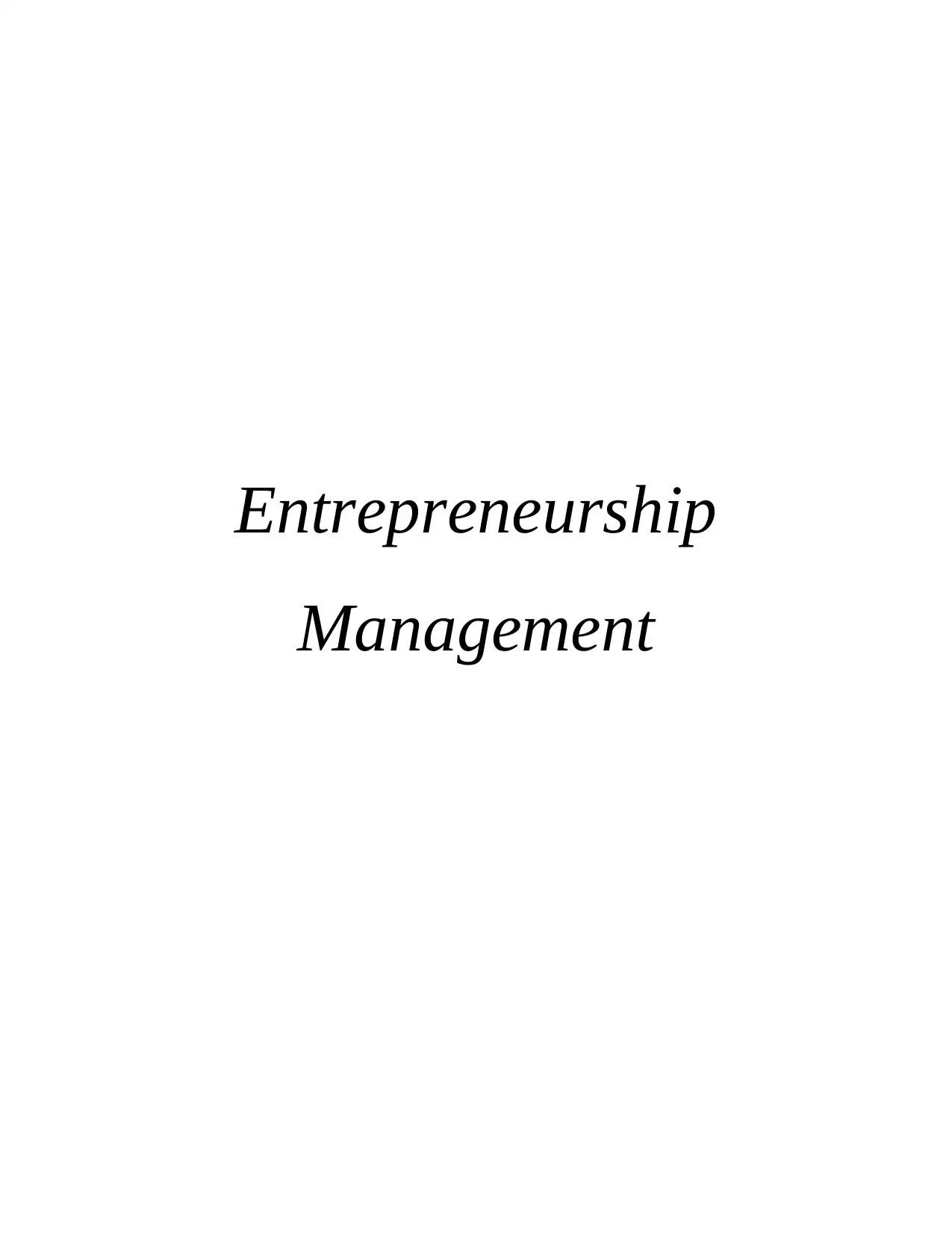
Entrepreneurship
Management
Management
Paraphrase This Document
Need a fresh take? Get an instant paraphrase of this document with our AI Paraphraser
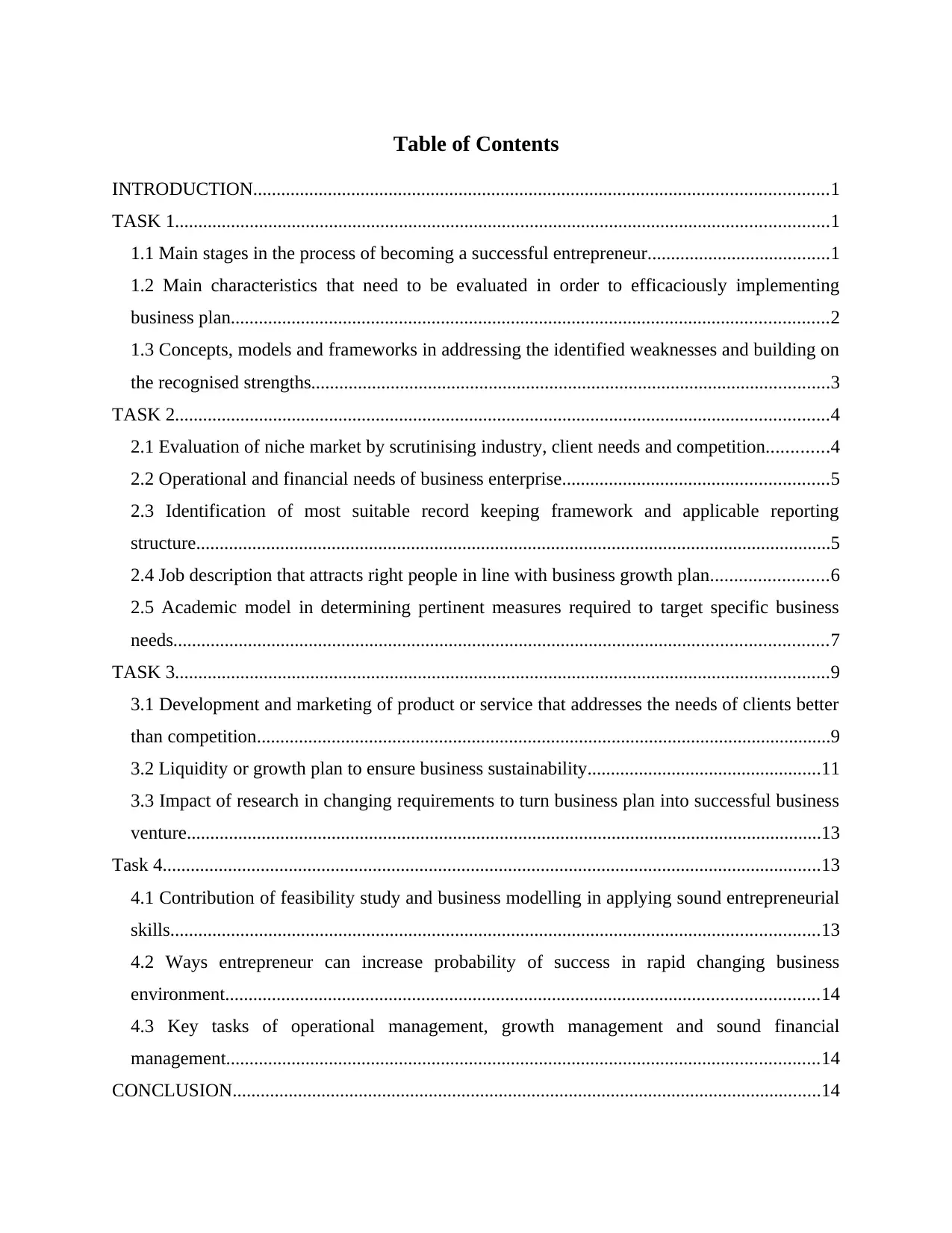
Table of Contents
INTRODUCTION...........................................................................................................................1
TASK 1............................................................................................................................................1
1.1 Main stages in the process of becoming a successful entrepreneur.......................................1
1.2 Main characteristics that need to be evaluated in order to efficaciously implementing
business plan................................................................................................................................2
1.3 Concepts, models and frameworks in addressing the identified weaknesses and building on
the recognised strengths...............................................................................................................3
TASK 2............................................................................................................................................4
2.1 Evaluation of niche market by scrutinising industry, client needs and competition.............4
2.2 Operational and financial needs of business enterprise.........................................................5
2.3 Identification of most suitable record keeping framework and applicable reporting
structure........................................................................................................................................5
2.4 Job description that attracts right people in line with business growth plan.........................6
2.5 Academic model in determining pertinent measures required to target specific business
needs............................................................................................................................................7
TASK 3............................................................................................................................................9
3.1 Development and marketing of product or service that addresses the needs of clients better
than competition...........................................................................................................................9
3.2 Liquidity or growth plan to ensure business sustainability..................................................11
3.3 Impact of research in changing requirements to turn business plan into successful business
venture........................................................................................................................................13
Task 4.............................................................................................................................................13
4.1 Contribution of feasibility study and business modelling in applying sound entrepreneurial
skills...........................................................................................................................................13
4.2 Ways entrepreneur can increase probability of success in rapid changing business
environment...............................................................................................................................14
4.3 Key tasks of operational management, growth management and sound financial
management...............................................................................................................................14
CONCLUSION..............................................................................................................................14
INTRODUCTION...........................................................................................................................1
TASK 1............................................................................................................................................1
1.1 Main stages in the process of becoming a successful entrepreneur.......................................1
1.2 Main characteristics that need to be evaluated in order to efficaciously implementing
business plan................................................................................................................................2
1.3 Concepts, models and frameworks in addressing the identified weaknesses and building on
the recognised strengths...............................................................................................................3
TASK 2............................................................................................................................................4
2.1 Evaluation of niche market by scrutinising industry, client needs and competition.............4
2.2 Operational and financial needs of business enterprise.........................................................5
2.3 Identification of most suitable record keeping framework and applicable reporting
structure........................................................................................................................................5
2.4 Job description that attracts right people in line with business growth plan.........................6
2.5 Academic model in determining pertinent measures required to target specific business
needs............................................................................................................................................7
TASK 3............................................................................................................................................9
3.1 Development and marketing of product or service that addresses the needs of clients better
than competition...........................................................................................................................9
3.2 Liquidity or growth plan to ensure business sustainability..................................................11
3.3 Impact of research in changing requirements to turn business plan into successful business
venture........................................................................................................................................13
Task 4.............................................................................................................................................13
4.1 Contribution of feasibility study and business modelling in applying sound entrepreneurial
skills...........................................................................................................................................13
4.2 Ways entrepreneur can increase probability of success in rapid changing business
environment...............................................................................................................................14
4.3 Key tasks of operational management, growth management and sound financial
management...............................................................................................................................14
CONCLUSION..............................................................................................................................14

REFERENCES..............................................................................................................................16
APPENDICES...............................................................................................................................17
APPENDICES...............................................................................................................................17
⊘ This is a preview!⊘
Do you want full access?
Subscribe today to unlock all pages.

Trusted by 1+ million students worldwide
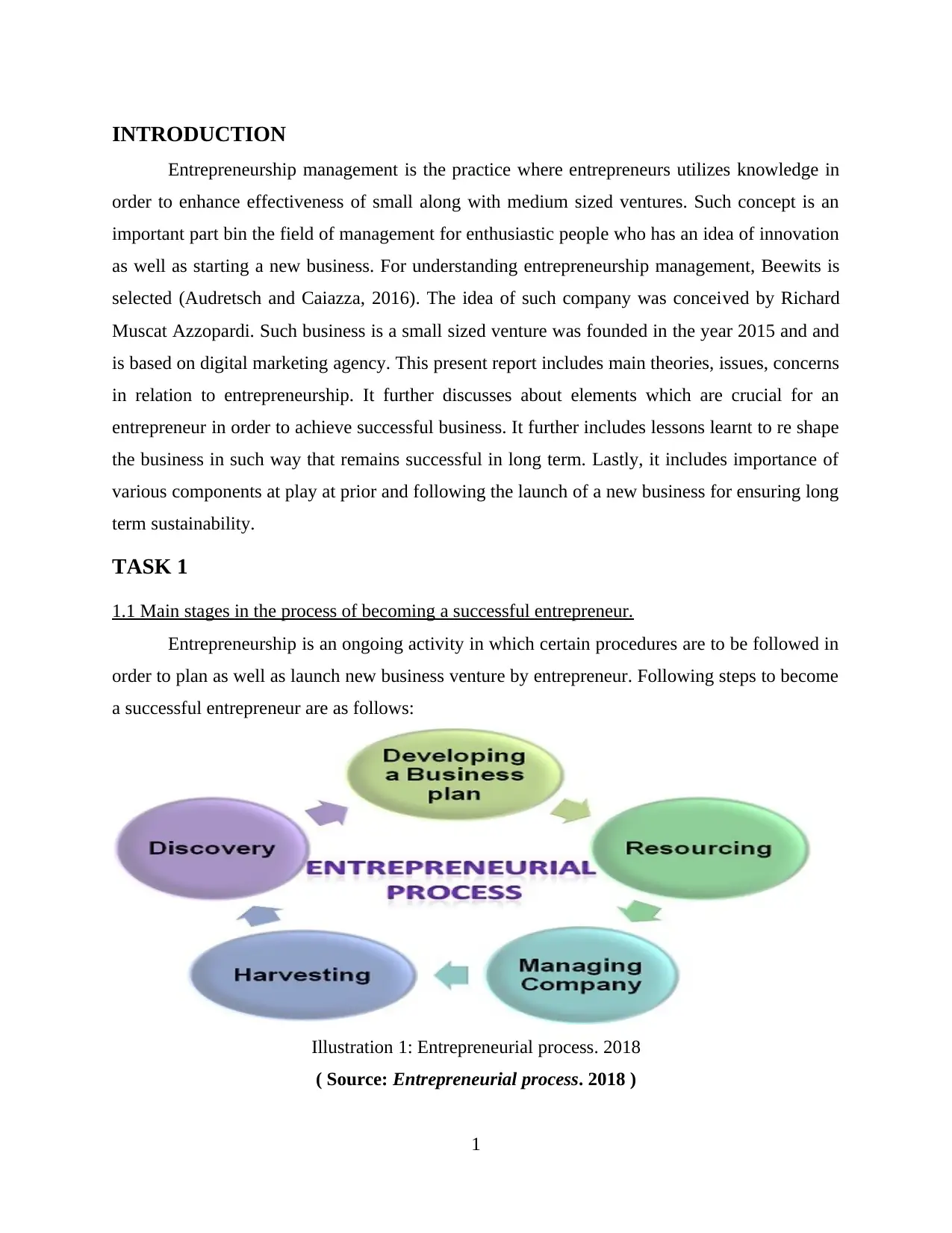
INTRODUCTION
Entrepreneurship management is the practice where entrepreneurs utilizes knowledge in
order to enhance effectiveness of small along with medium sized ventures. Such concept is an
important part bin the field of management for enthusiastic people who has an idea of innovation
as well as starting a new business. For understanding entrepreneurship management, Beewits is
selected (Audretsch and Caiazza, 2016). The idea of such company was conceived by Richard
Muscat Azzopardi. Such business is a small sized venture was founded in the year 2015 and and
is based on digital marketing agency. This present report includes main theories, issues, concerns
in relation to entrepreneurship. It further discusses about elements which are crucial for an
entrepreneur in order to achieve successful business. It further includes lessons learnt to re shape
the business in such way that remains successful in long term. Lastly, it includes importance of
various components at play at prior and following the launch of a new business for ensuring long
term sustainability.
TASK 1
1.1 Main stages in the process of becoming a successful entrepreneur.
Entrepreneurship is an ongoing activity in which certain procedures are to be followed in
order to plan as well as launch new business venture by entrepreneur. Following steps to become
a successful entrepreneur are as follows:
Illustration 1: Entrepreneurial process. 2018
( Source: Entrepreneurial process. 2018 )
1
Entrepreneurship management is the practice where entrepreneurs utilizes knowledge in
order to enhance effectiveness of small along with medium sized ventures. Such concept is an
important part bin the field of management for enthusiastic people who has an idea of innovation
as well as starting a new business. For understanding entrepreneurship management, Beewits is
selected (Audretsch and Caiazza, 2016). The idea of such company was conceived by Richard
Muscat Azzopardi. Such business is a small sized venture was founded in the year 2015 and and
is based on digital marketing agency. This present report includes main theories, issues, concerns
in relation to entrepreneurship. It further discusses about elements which are crucial for an
entrepreneur in order to achieve successful business. It further includes lessons learnt to re shape
the business in such way that remains successful in long term. Lastly, it includes importance of
various components at play at prior and following the launch of a new business for ensuring long
term sustainability.
TASK 1
1.1 Main stages in the process of becoming a successful entrepreneur.
Entrepreneurship is an ongoing activity in which certain procedures are to be followed in
order to plan as well as launch new business venture by entrepreneur. Following steps to become
a successful entrepreneur are as follows:
Illustration 1: Entrepreneurial process. 2018
( Source: Entrepreneurial process. 2018 )
1
Paraphrase This Document
Need a fresh take? Get an instant paraphrase of this document with our AI Paraphraser
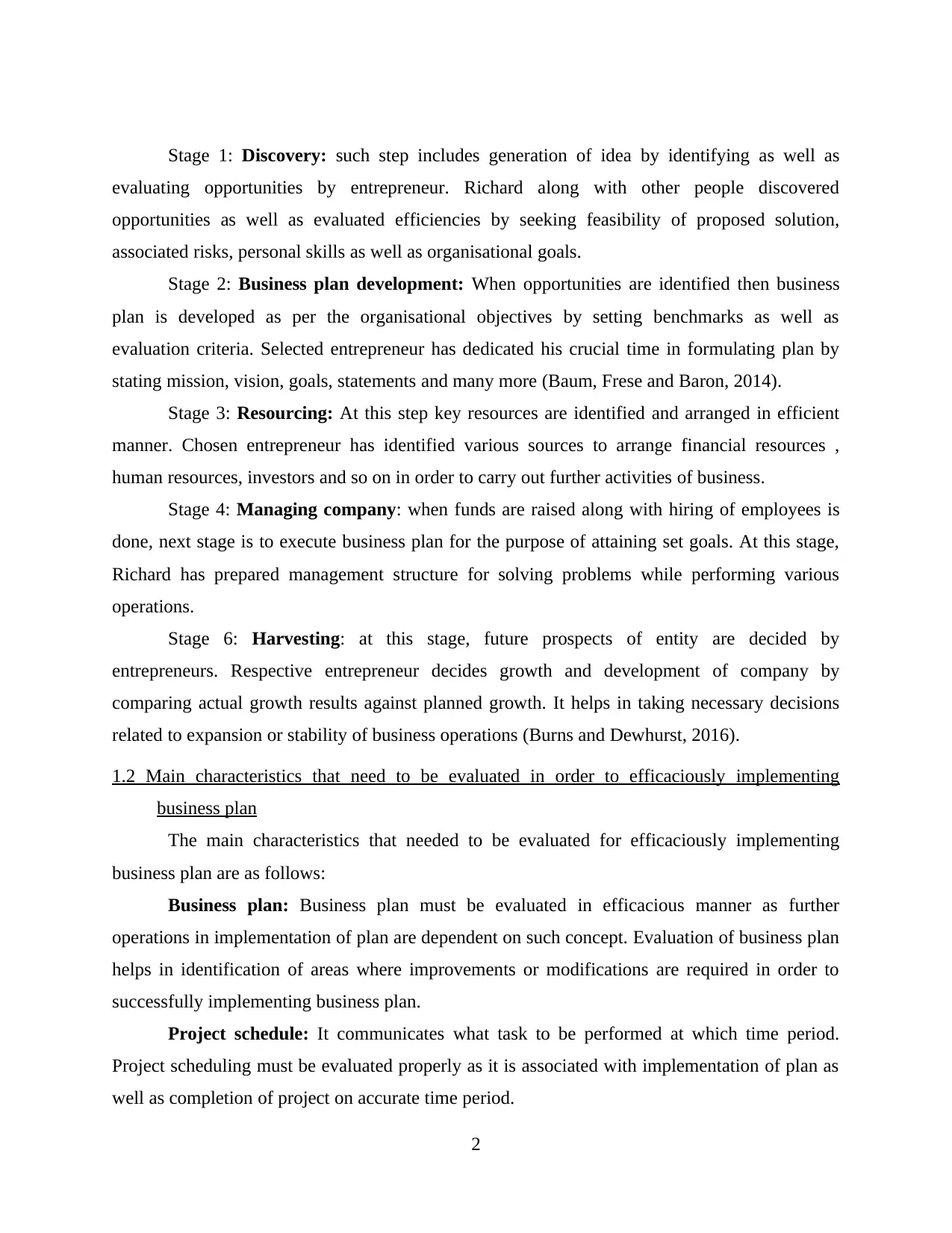
Stage 1: Discovery: such step includes generation of idea by identifying as well as
evaluating opportunities by entrepreneur. Richard along with other people discovered
opportunities as well as evaluated efficiencies by seeking feasibility of proposed solution,
associated risks, personal skills as well as organisational goals.
Stage 2: Business plan development: When opportunities are identified then business
plan is developed as per the organisational objectives by setting benchmarks as well as
evaluation criteria. Selected entrepreneur has dedicated his crucial time in formulating plan by
stating mission, vision, goals, statements and many more (Baum, Frese and Baron, 2014).
Stage 3: Resourcing: At this step key resources are identified and arranged in efficient
manner. Chosen entrepreneur has identified various sources to arrange financial resources ,
human resources, investors and so on in order to carry out further activities of business.
Stage 4: Managing company: when funds are raised along with hiring of employees is
done, next stage is to execute business plan for the purpose of attaining set goals. At this stage,
Richard has prepared management structure for solving problems while performing various
operations.
Stage 6: Harvesting: at this stage, future prospects of entity are decided by
entrepreneurs. Respective entrepreneur decides growth and development of company by
comparing actual growth results against planned growth. It helps in taking necessary decisions
related to expansion or stability of business operations (Burns and Dewhurst, 2016).
1.2 Main characteristics that need to be evaluated in order to efficaciously implementing
business plan
The main characteristics that needed to be evaluated for efficaciously implementing
business plan are as follows:
Business plan: Business plan must be evaluated in efficacious manner as further
operations in implementation of plan are dependent on such concept. Evaluation of business plan
helps in identification of areas where improvements or modifications are required in order to
successfully implementing business plan.
Project schedule: It communicates what task to be performed at which time period.
Project scheduling must be evaluated properly as it is associated with implementation of plan as
well as completion of project on accurate time period.
2
evaluating opportunities by entrepreneur. Richard along with other people discovered
opportunities as well as evaluated efficiencies by seeking feasibility of proposed solution,
associated risks, personal skills as well as organisational goals.
Stage 2: Business plan development: When opportunities are identified then business
plan is developed as per the organisational objectives by setting benchmarks as well as
evaluation criteria. Selected entrepreneur has dedicated his crucial time in formulating plan by
stating mission, vision, goals, statements and many more (Baum, Frese and Baron, 2014).
Stage 3: Resourcing: At this step key resources are identified and arranged in efficient
manner. Chosen entrepreneur has identified various sources to arrange financial resources ,
human resources, investors and so on in order to carry out further activities of business.
Stage 4: Managing company: when funds are raised along with hiring of employees is
done, next stage is to execute business plan for the purpose of attaining set goals. At this stage,
Richard has prepared management structure for solving problems while performing various
operations.
Stage 6: Harvesting: at this stage, future prospects of entity are decided by
entrepreneurs. Respective entrepreneur decides growth and development of company by
comparing actual growth results against planned growth. It helps in taking necessary decisions
related to expansion or stability of business operations (Burns and Dewhurst, 2016).
1.2 Main characteristics that need to be evaluated in order to efficaciously implementing
business plan
The main characteristics that needed to be evaluated for efficaciously implementing
business plan are as follows:
Business plan: Business plan must be evaluated in efficacious manner as further
operations in implementation of plan are dependent on such concept. Evaluation of business plan
helps in identification of areas where improvements or modifications are required in order to
successfully implementing business plan.
Project schedule: It communicates what task to be performed at which time period.
Project scheduling must be evaluated properly as it is associated with implementation of plan as
well as completion of project on accurate time period.
2
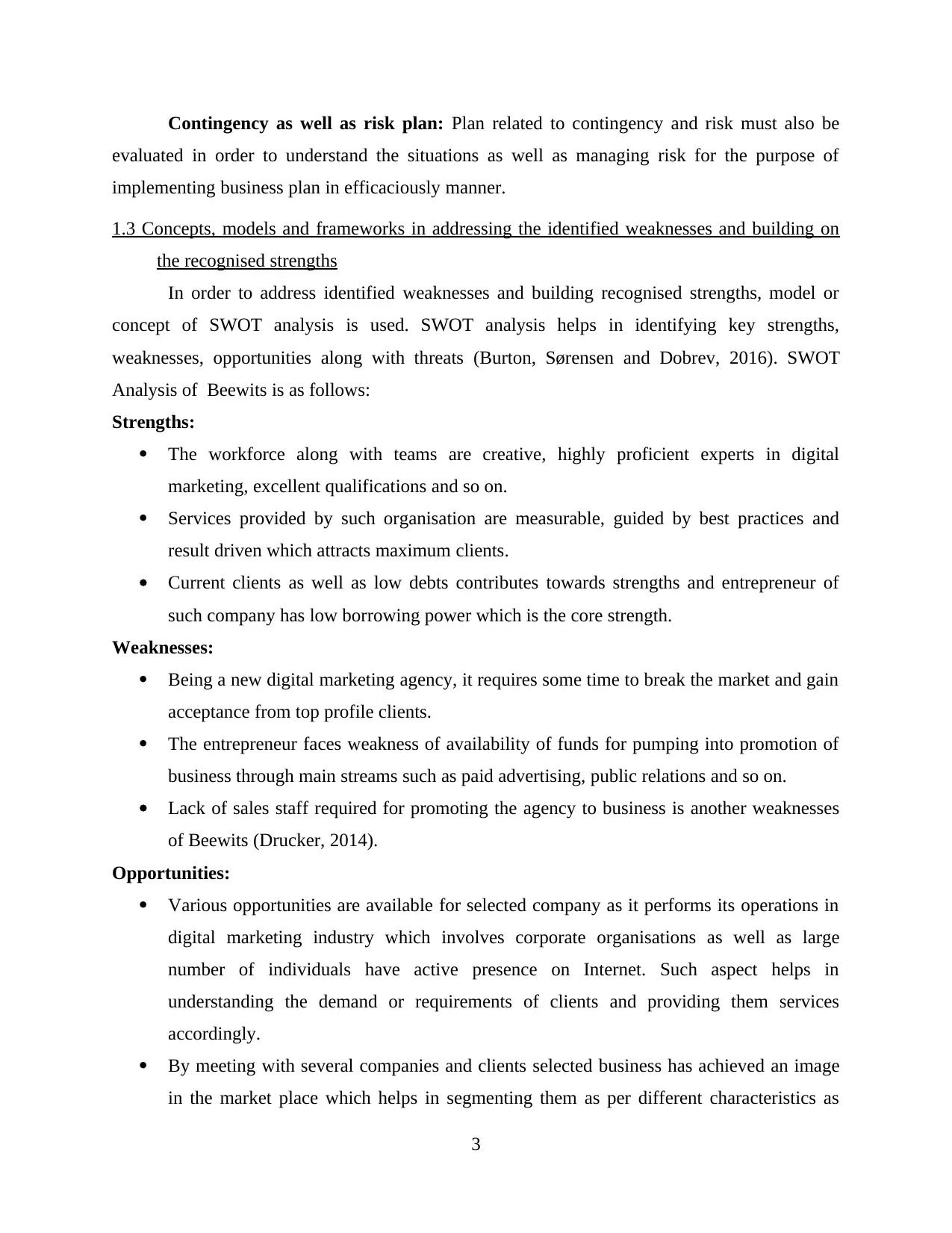
Contingency as well as risk plan: Plan related to contingency and risk must also be
evaluated in order to understand the situations as well as managing risk for the purpose of
implementing business plan in efficaciously manner.
1.3 Concepts, models and frameworks in addressing the identified weaknesses and building on
the recognised strengths
In order to address identified weaknesses and building recognised strengths, model or
concept of SWOT analysis is used. SWOT analysis helps in identifying key strengths,
weaknesses, opportunities along with threats (Burton, Sørensen and Dobrev, 2016). SWOT
Analysis of Beewits is as follows:
Strengths:
The workforce along with teams are creative, highly proficient experts in digital
marketing, excellent qualifications and so on.
Services provided by such organisation are measurable, guided by best practices and
result driven which attracts maximum clients.
Current clients as well as low debts contributes towards strengths and entrepreneur of
such company has low borrowing power which is the core strength.
Weaknesses:
Being a new digital marketing agency, it requires some time to break the market and gain
acceptance from top profile clients.
The entrepreneur faces weakness of availability of funds for pumping into promotion of
business through main streams such as paid advertising, public relations and so on.
Lack of sales staff required for promoting the agency to business is another weaknesses
of Beewits (Drucker, 2014).
Opportunities:
Various opportunities are available for selected company as it performs its operations in
digital marketing industry which involves corporate organisations as well as large
number of individuals have active presence on Internet. Such aspect helps in
understanding the demand or requirements of clients and providing them services
accordingly.
By meeting with several companies and clients selected business has achieved an image
in the market place which helps in segmenting them as per different characteristics as
3
evaluated in order to understand the situations as well as managing risk for the purpose of
implementing business plan in efficaciously manner.
1.3 Concepts, models and frameworks in addressing the identified weaknesses and building on
the recognised strengths
In order to address identified weaknesses and building recognised strengths, model or
concept of SWOT analysis is used. SWOT analysis helps in identifying key strengths,
weaknesses, opportunities along with threats (Burton, Sørensen and Dobrev, 2016). SWOT
Analysis of Beewits is as follows:
Strengths:
The workforce along with teams are creative, highly proficient experts in digital
marketing, excellent qualifications and so on.
Services provided by such organisation are measurable, guided by best practices and
result driven which attracts maximum clients.
Current clients as well as low debts contributes towards strengths and entrepreneur of
such company has low borrowing power which is the core strength.
Weaknesses:
Being a new digital marketing agency, it requires some time to break the market and gain
acceptance from top profile clients.
The entrepreneur faces weakness of availability of funds for pumping into promotion of
business through main streams such as paid advertising, public relations and so on.
Lack of sales staff required for promoting the agency to business is another weaknesses
of Beewits (Drucker, 2014).
Opportunities:
Various opportunities are available for selected company as it performs its operations in
digital marketing industry which involves corporate organisations as well as large
number of individuals have active presence on Internet. Such aspect helps in
understanding the demand or requirements of clients and providing them services
accordingly.
By meeting with several companies and clients selected business has achieved an image
in the market place which helps in segmenting them as per different characteristics as
3
⊘ This is a preview!⊘
Do you want full access?
Subscribe today to unlock all pages.

Trusted by 1+ million students worldwide
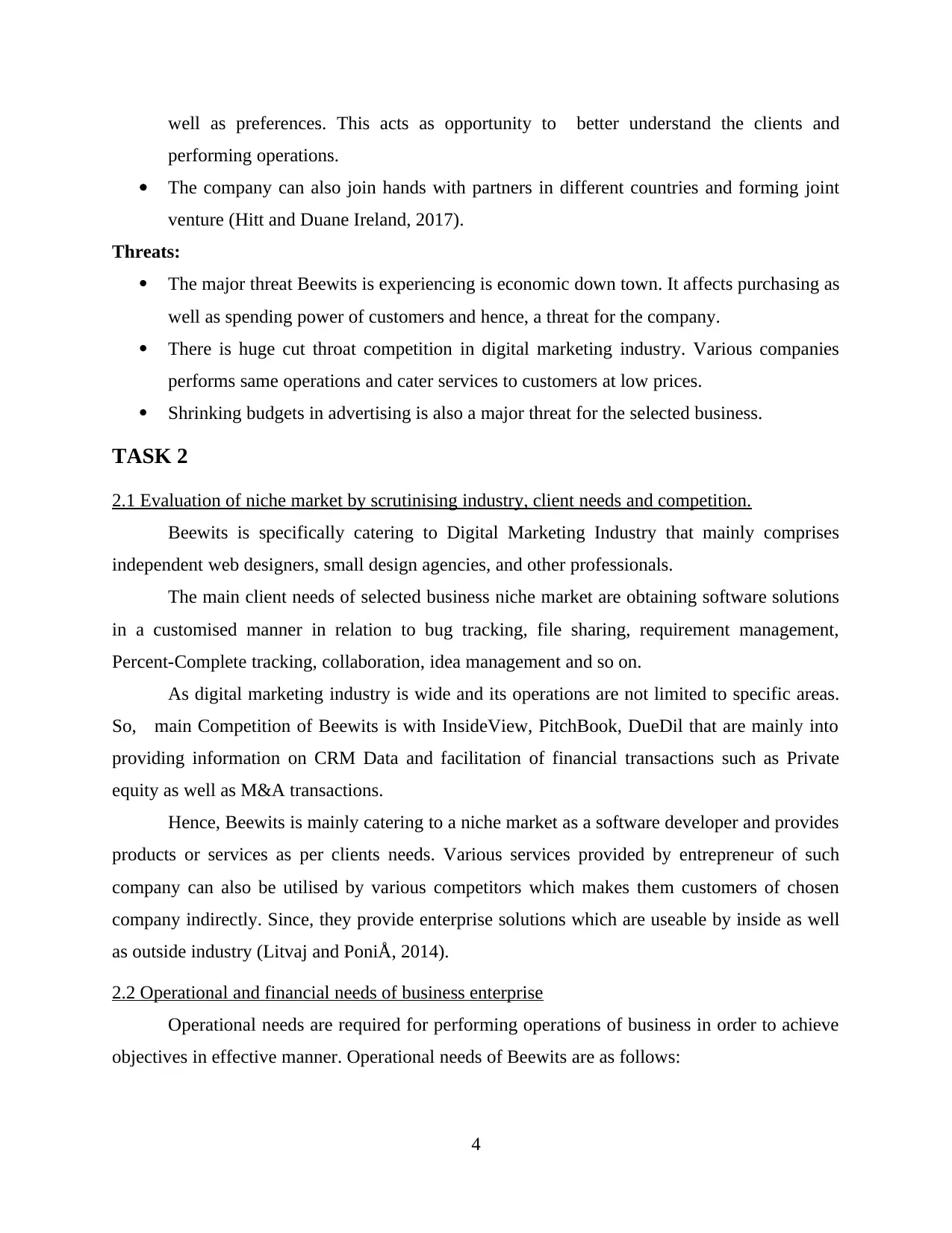
well as preferences. This acts as opportunity to better understand the clients and
performing operations.
The company can also join hands with partners in different countries and forming joint
venture (Hitt and Duane Ireland, 2017).
Threats:
The major threat Beewits is experiencing is economic down town. It affects purchasing as
well as spending power of customers and hence, a threat for the company.
There is huge cut throat competition in digital marketing industry. Various companies
performs same operations and cater services to customers at low prices.
Shrinking budgets in advertising is also a major threat for the selected business.
TASK 2
2.1 Evaluation of niche market by scrutinising industry, client needs and competition.
Beewits is specifically catering to Digital Marketing Industry that mainly comprises
independent web designers, small design agencies, and other professionals.
The main client needs of selected business niche market are obtaining software solutions
in a customised manner in relation to bug tracking, file sharing, requirement management,
Percent-Complete tracking, collaboration, idea management and so on.
As digital marketing industry is wide and its operations are not limited to specific areas.
So, main Competition of Beewits is with InsideView, PitchBook, DueDil that are mainly into
providing information on CRM Data and facilitation of financial transactions such as Private
equity as well as M&A transactions.
Hence, Beewits is mainly catering to a niche market as a software developer and provides
products or services as per clients needs. Various services provided by entrepreneur of such
company can also be utilised by various competitors which makes them customers of chosen
company indirectly. Since, they provide enterprise solutions which are useable by inside as well
as outside industry (Litvaj and PoniÅ, 2014).
2.2 Operational and financial needs of business enterprise
Operational needs are required for performing operations of business in order to achieve
objectives in effective manner. Operational needs of Beewits are as follows:
4
performing operations.
The company can also join hands with partners in different countries and forming joint
venture (Hitt and Duane Ireland, 2017).
Threats:
The major threat Beewits is experiencing is economic down town. It affects purchasing as
well as spending power of customers and hence, a threat for the company.
There is huge cut throat competition in digital marketing industry. Various companies
performs same operations and cater services to customers at low prices.
Shrinking budgets in advertising is also a major threat for the selected business.
TASK 2
2.1 Evaluation of niche market by scrutinising industry, client needs and competition.
Beewits is specifically catering to Digital Marketing Industry that mainly comprises
independent web designers, small design agencies, and other professionals.
The main client needs of selected business niche market are obtaining software solutions
in a customised manner in relation to bug tracking, file sharing, requirement management,
Percent-Complete tracking, collaboration, idea management and so on.
As digital marketing industry is wide and its operations are not limited to specific areas.
So, main Competition of Beewits is with InsideView, PitchBook, DueDil that are mainly into
providing information on CRM Data and facilitation of financial transactions such as Private
equity as well as M&A transactions.
Hence, Beewits is mainly catering to a niche market as a software developer and provides
products or services as per clients needs. Various services provided by entrepreneur of such
company can also be utilised by various competitors which makes them customers of chosen
company indirectly. Since, they provide enterprise solutions which are useable by inside as well
as outside industry (Litvaj and PoniÅ, 2014).
2.2 Operational and financial needs of business enterprise
Operational needs are required for performing operations of business in order to achieve
objectives in effective manner. Operational needs of Beewits are as follows:
4
Paraphrase This Document
Need a fresh take? Get an instant paraphrase of this document with our AI Paraphraser
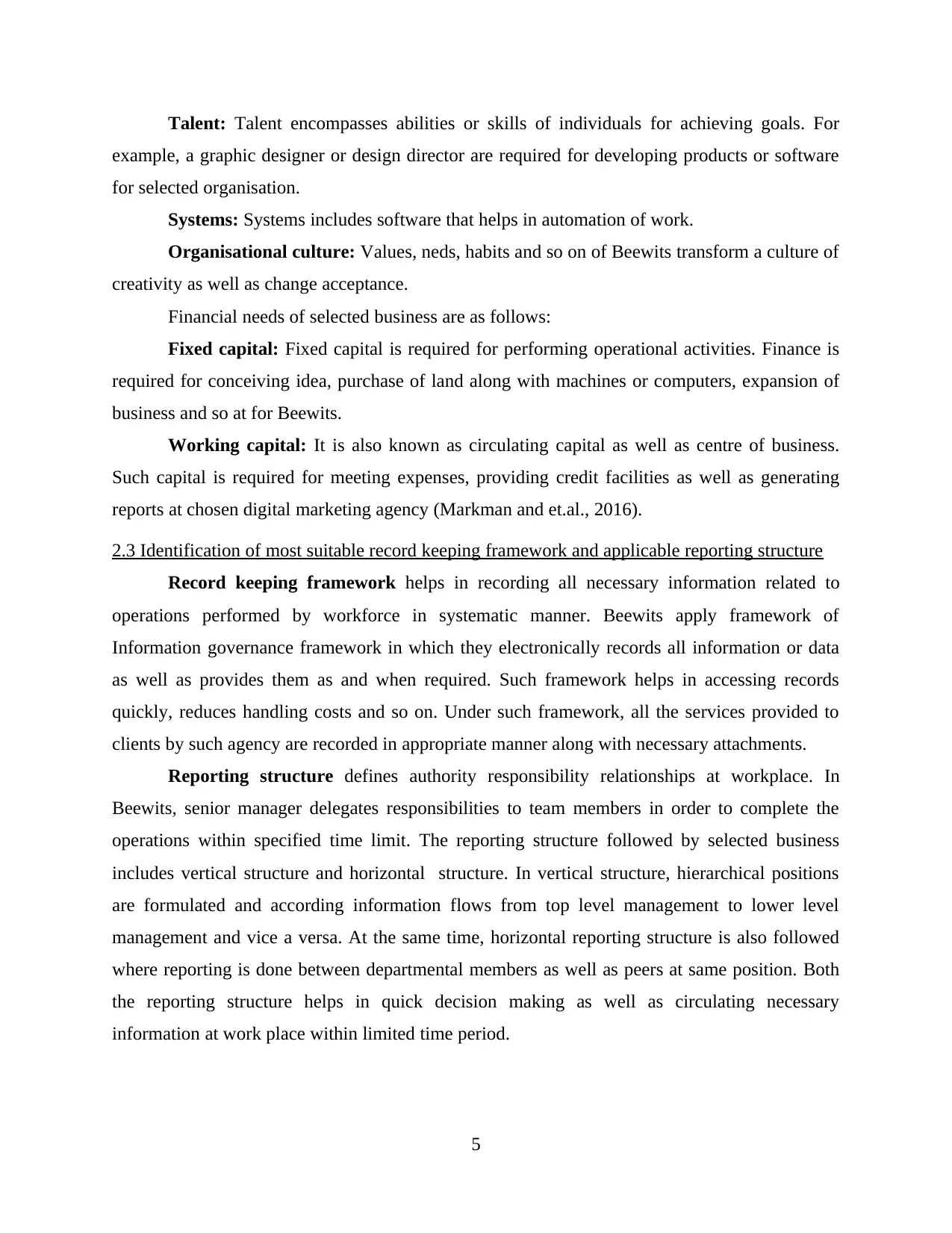
Talent: Talent encompasses abilities or skills of individuals for achieving goals. For
example, a graphic designer or design director are required for developing products or software
for selected organisation.
Systems: Systems includes software that helps in automation of work.
Organisational culture: Values, neds, habits and so on of Beewits transform a culture of
creativity as well as change acceptance.
Financial needs of selected business are as follows:
Fixed capital: Fixed capital is required for performing operational activities. Finance is
required for conceiving idea, purchase of land along with machines or computers, expansion of
business and so at for Beewits.
Working capital: It is also known as circulating capital as well as centre of business.
Such capital is required for meeting expenses, providing credit facilities as well as generating
reports at chosen digital marketing agency (Markman and et.al., 2016).
2.3 Identification of most suitable record keeping framework and applicable reporting structure
Record keeping framework helps in recording all necessary information related to
operations performed by workforce in systematic manner. Beewits apply framework of
Information governance framework in which they electronically records all information or data
as well as provides them as and when required. Such framework helps in accessing records
quickly, reduces handling costs and so on. Under such framework, all the services provided to
clients by such agency are recorded in appropriate manner along with necessary attachments.
Reporting structure defines authority responsibility relationships at workplace. In
Beewits, senior manager delegates responsibilities to team members in order to complete the
operations within specified time limit. The reporting structure followed by selected business
includes vertical structure and horizontal structure. In vertical structure, hierarchical positions
are formulated and according information flows from top level management to lower level
management and vice a versa. At the same time, horizontal reporting structure is also followed
where reporting is done between departmental members as well as peers at same position. Both
the reporting structure helps in quick decision making as well as circulating necessary
information at work place within limited time period.
5
example, a graphic designer or design director are required for developing products or software
for selected organisation.
Systems: Systems includes software that helps in automation of work.
Organisational culture: Values, neds, habits and so on of Beewits transform a culture of
creativity as well as change acceptance.
Financial needs of selected business are as follows:
Fixed capital: Fixed capital is required for performing operational activities. Finance is
required for conceiving idea, purchase of land along with machines or computers, expansion of
business and so at for Beewits.
Working capital: It is also known as circulating capital as well as centre of business.
Such capital is required for meeting expenses, providing credit facilities as well as generating
reports at chosen digital marketing agency (Markman and et.al., 2016).
2.3 Identification of most suitable record keeping framework and applicable reporting structure
Record keeping framework helps in recording all necessary information related to
operations performed by workforce in systematic manner. Beewits apply framework of
Information governance framework in which they electronically records all information or data
as well as provides them as and when required. Such framework helps in accessing records
quickly, reduces handling costs and so on. Under such framework, all the services provided to
clients by such agency are recorded in appropriate manner along with necessary attachments.
Reporting structure defines authority responsibility relationships at workplace. In
Beewits, senior manager delegates responsibilities to team members in order to complete the
operations within specified time limit. The reporting structure followed by selected business
includes vertical structure and horizontal structure. In vertical structure, hierarchical positions
are formulated and according information flows from top level management to lower level
management and vice a versa. At the same time, horizontal reporting structure is also followed
where reporting is done between departmental members as well as peers at same position. Both
the reporting structure helps in quick decision making as well as circulating necessary
information at work place within limited time period.
5
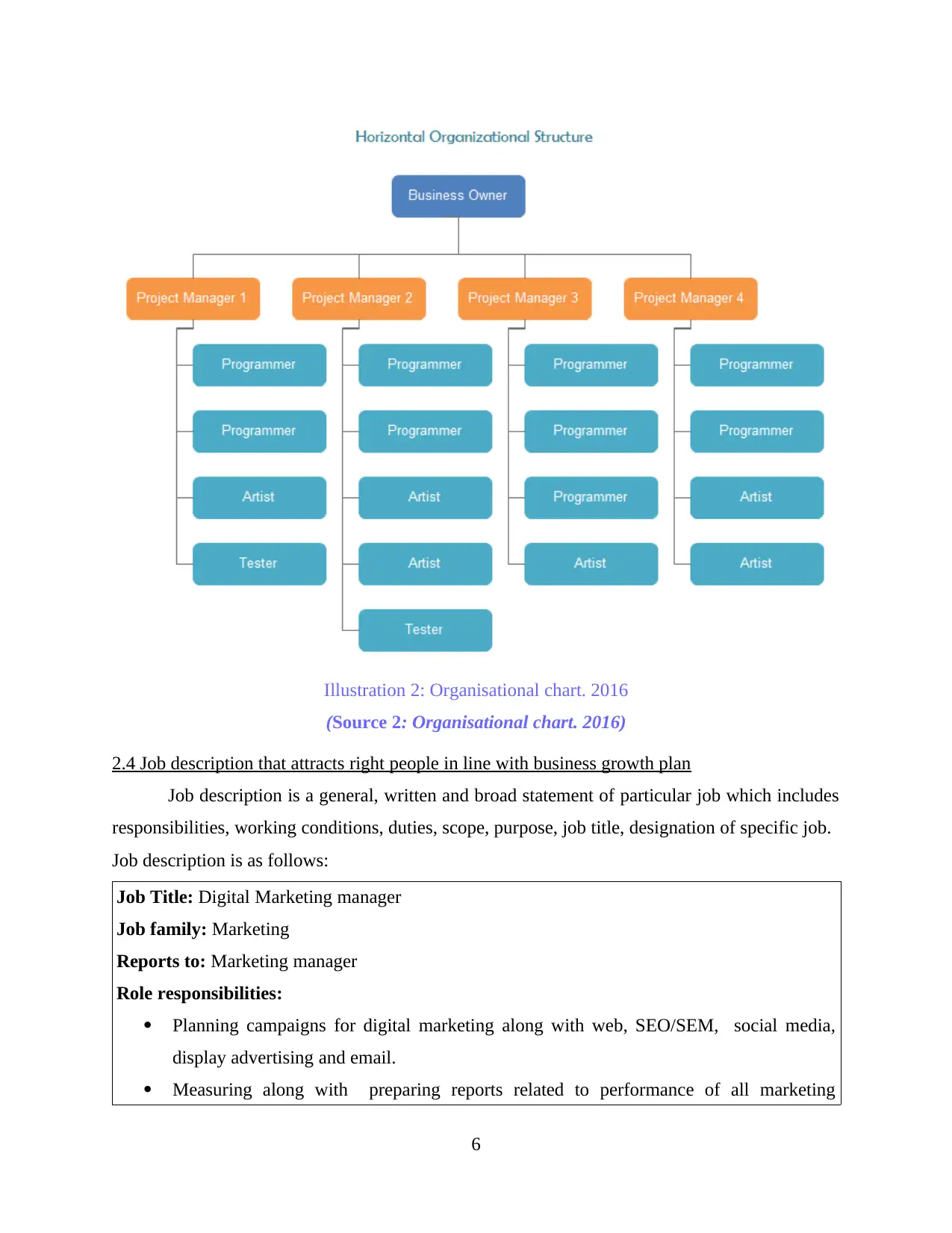
Illustration 2: Organisational chart. 2016
(Source 2: Organisational chart. 2016)
2.4 Job description that attracts right people in line with business growth plan
Job description is a general, written and broad statement of particular job which includes
responsibilities, working conditions, duties, scope, purpose, job title, designation of specific job.
Job description is as follows:
Job Title: Digital Marketing manager
Job family: Marketing
Reports to: Marketing manager
Role responsibilities:
Planning campaigns for digital marketing along with web, SEO/SEM, social media,
display advertising and email.
Measuring along with preparing reports related to performance of all marketing
6
(Source 2: Organisational chart. 2016)
2.4 Job description that attracts right people in line with business growth plan
Job description is a general, written and broad statement of particular job which includes
responsibilities, working conditions, duties, scope, purpose, job title, designation of specific job.
Job description is as follows:
Job Title: Digital Marketing manager
Job family: Marketing
Reports to: Marketing manager
Role responsibilities:
Planning campaigns for digital marketing along with web, SEO/SEM, social media,
display advertising and email.
Measuring along with preparing reports related to performance of all marketing
6
⊘ This is a preview!⊘
Do you want full access?
Subscribe today to unlock all pages.

Trusted by 1+ million students worldwide
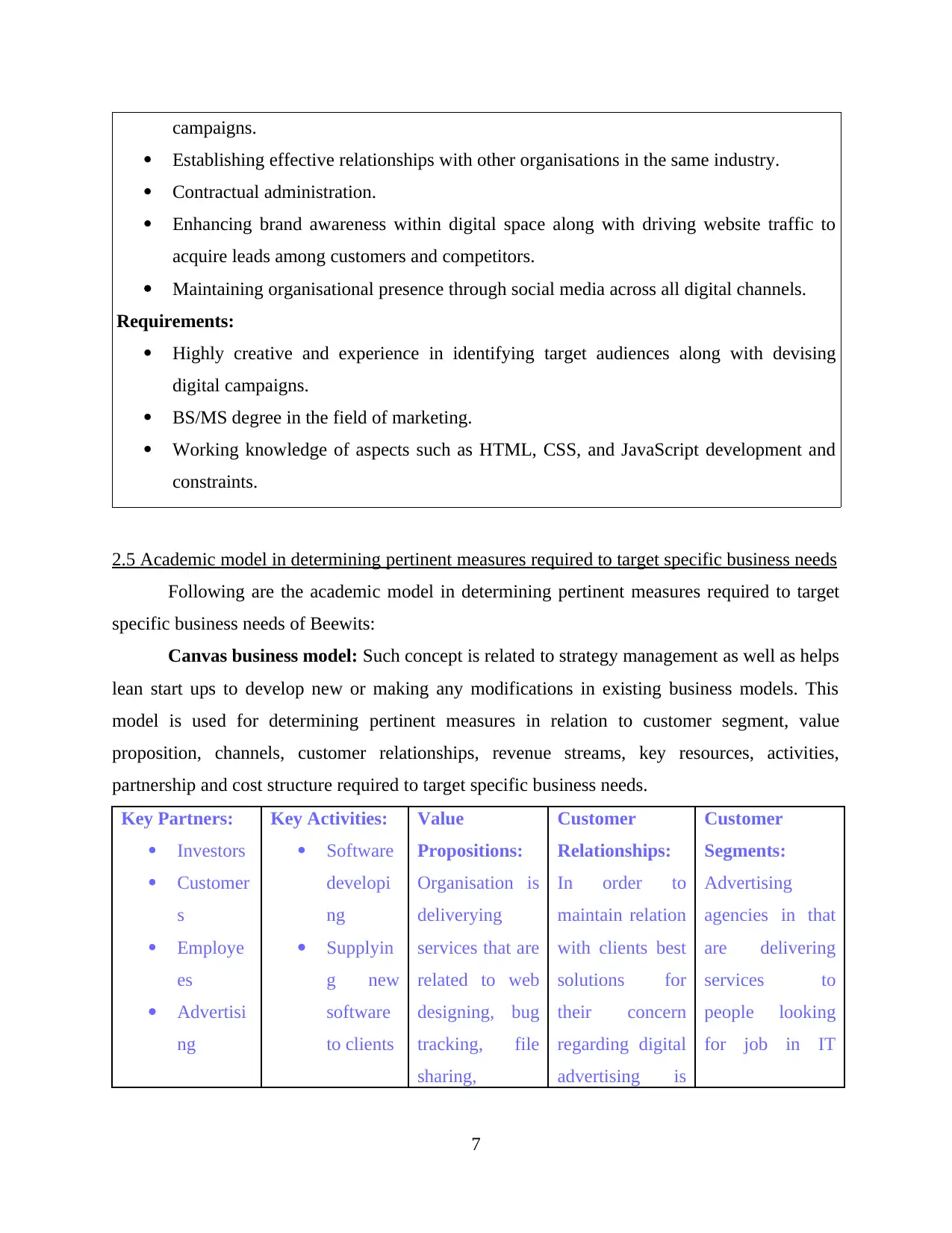
campaigns.
Establishing effective relationships with other organisations in the same industry.
Contractual administration.
Enhancing brand awareness within digital space along with driving website traffic to
acquire leads among customers and competitors.
Maintaining organisational presence through social media across all digital channels.
Requirements:
Highly creative and experience in identifying target audiences along with devising
digital campaigns.
BS/MS degree in the field of marketing.
Working knowledge of aspects such as HTML, CSS, and JavaScript development and
constraints.
2.5 Academic model in determining pertinent measures required to target specific business needs
Following are the academic model in determining pertinent measures required to target
specific business needs of Beewits:
Canvas business model: Such concept is related to strategy management as well as helps
lean start ups to develop new or making any modifications in existing business models. This
model is used for determining pertinent measures in relation to customer segment, value
proposition, channels, customer relationships, revenue streams, key resources, activities,
partnership and cost structure required to target specific business needs.
Key Partners:
Investors
Customer
s
Employe
es
Advertisi
ng
Key Activities:
Software
developi
ng
Supplyin
g new
software
to clients
Value
Propositions:
Organisation is
deliverying
services that are
related to web
designing, bug
tracking, file
sharing,
Customer
Relationships:
In order to
maintain relation
with clients best
solutions for
their concern
regarding digital
advertising is
Customer
Segments:
Advertising
agencies in that
are delivering
services to
people looking
for job in IT
7
Establishing effective relationships with other organisations in the same industry.
Contractual administration.
Enhancing brand awareness within digital space along with driving website traffic to
acquire leads among customers and competitors.
Maintaining organisational presence through social media across all digital channels.
Requirements:
Highly creative and experience in identifying target audiences along with devising
digital campaigns.
BS/MS degree in the field of marketing.
Working knowledge of aspects such as HTML, CSS, and JavaScript development and
constraints.
2.5 Academic model in determining pertinent measures required to target specific business needs
Following are the academic model in determining pertinent measures required to target
specific business needs of Beewits:
Canvas business model: Such concept is related to strategy management as well as helps
lean start ups to develop new or making any modifications in existing business models. This
model is used for determining pertinent measures in relation to customer segment, value
proposition, channels, customer relationships, revenue streams, key resources, activities,
partnership and cost structure required to target specific business needs.
Key Partners:
Investors
Customer
s
Employe
es
Advertisi
ng
Key Activities:
Software
developi
ng
Supplyin
g new
software
to clients
Value
Propositions:
Organisation is
deliverying
services that are
related to web
designing, bug
tracking, file
sharing,
Customer
Relationships:
In order to
maintain relation
with clients best
solutions for
their concern
regarding digital
advertising is
Customer
Segments:
Advertising
agencies in that
are delivering
services to
people looking
for job in IT
7
Paraphrase This Document
Need a fresh take? Get an instant paraphrase of this document with our AI Paraphraser
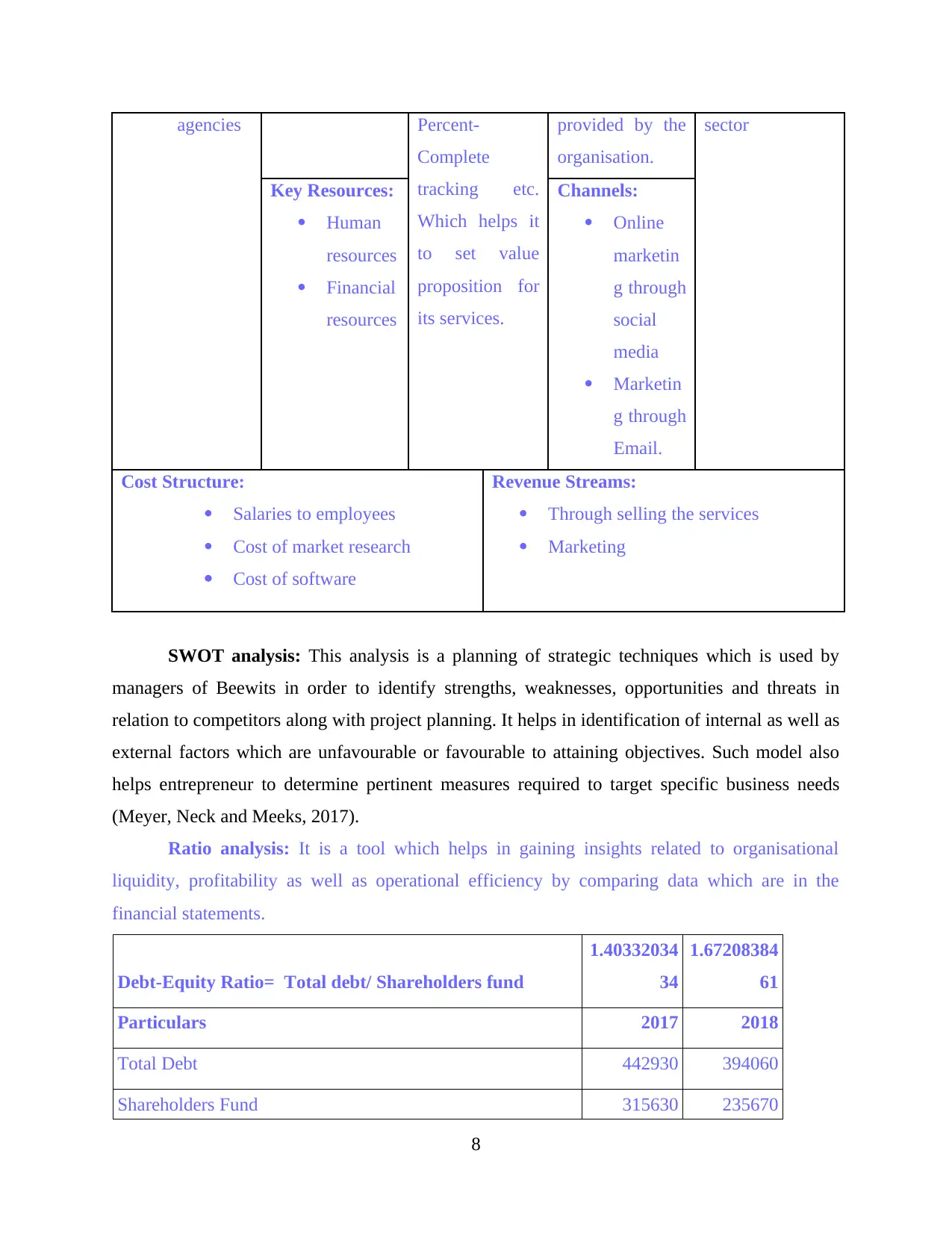
agencies Percent-
Complete
tracking etc.
Which helps it
to set value
proposition for
its services.
provided by the
organisation.
sector
Key Resources:
Human
resources
Financial
resources
Channels:
Online
marketin
g through
social
media
Marketin
g through
Email.
Cost Structure:
Salaries to employees
Cost of market research
Cost of software
Revenue Streams:
Through selling the services
Marketing
SWOT analysis: This analysis is a planning of strategic techniques which is used by
managers of Beewits in order to identify strengths, weaknesses, opportunities and threats in
relation to competitors along with project planning. It helps in identification of internal as well as
external factors which are unfavourable or favourable to attaining objectives. Such model also
helps entrepreneur to determine pertinent measures required to target specific business needs
(Meyer, Neck and Meeks, 2017).
Ratio analysis: It is a tool which helps in gaining insights related to organisational
liquidity, profitability as well as operational efficiency by comparing data which are in the
financial statements.
Debt-Equity Ratio= Total debt/ Shareholders fund
1.40332034
34
1.67208384
61
Particulars 2017 2018
Total Debt 442930 394060
Shareholders Fund 315630 235670
8
Complete
tracking etc.
Which helps it
to set value
proposition for
its services.
provided by the
organisation.
sector
Key Resources:
Human
resources
Financial
resources
Channels:
Online
marketin
g through
social
media
Marketin
g through
Email.
Cost Structure:
Salaries to employees
Cost of market research
Cost of software
Revenue Streams:
Through selling the services
Marketing
SWOT analysis: This analysis is a planning of strategic techniques which is used by
managers of Beewits in order to identify strengths, weaknesses, opportunities and threats in
relation to competitors along with project planning. It helps in identification of internal as well as
external factors which are unfavourable or favourable to attaining objectives. Such model also
helps entrepreneur to determine pertinent measures required to target specific business needs
(Meyer, Neck and Meeks, 2017).
Ratio analysis: It is a tool which helps in gaining insights related to organisational
liquidity, profitability as well as operational efficiency by comparing data which are in the
financial statements.
Debt-Equity Ratio= Total debt/ Shareholders fund
1.40332034
34
1.67208384
61
Particulars 2017 2018
Total Debt 442930 394060
Shareholders Fund 315630 235670
8
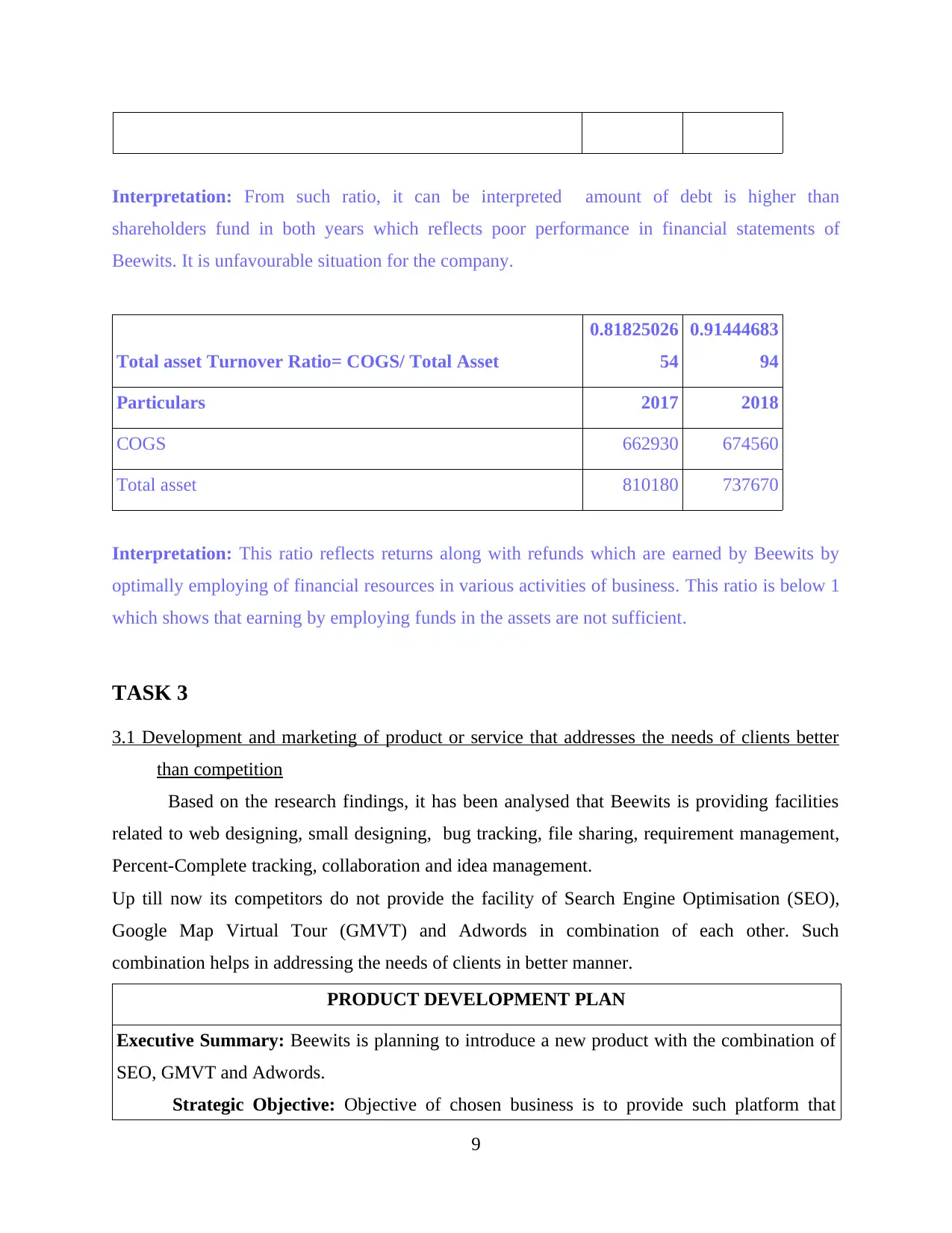
Interpretation: From such ratio, it can be interpreted amount of debt is higher than
shareholders fund in both years which reflects poor performance in financial statements of
Beewits. It is unfavourable situation for the company.
Total asset Turnover Ratio= COGS/ Total Asset
0.81825026
54
0.91444683
94
Particulars 2017 2018
COGS 662930 674560
Total asset 810180 737670
Interpretation: This ratio reflects returns along with refunds which are earned by Beewits by
optimally employing of financial resources in various activities of business. This ratio is below 1
which shows that earning by employing funds in the assets are not sufficient.
TASK 3
3.1 Development and marketing of product or service that addresses the needs of clients better
than competition
Based on the research findings, it has been analysed that Beewits is providing facilities
related to web designing, small designing, bug tracking, file sharing, requirement management,
Percent-Complete tracking, collaboration and idea management.
Up till now its competitors do not provide the facility of Search Engine Optimisation (SEO),
Google Map Virtual Tour (GMVT) and Adwords in combination of each other. Such
combination helps in addressing the needs of clients in better manner.
PRODUCT DEVELOPMENT PLAN
Executive Summary: Beewits is planning to introduce a new product with the combination of
SEO, GMVT and Adwords.
Strategic Objective: Objective of chosen business is to provide such platform that
9
shareholders fund in both years which reflects poor performance in financial statements of
Beewits. It is unfavourable situation for the company.
Total asset Turnover Ratio= COGS/ Total Asset
0.81825026
54
0.91444683
94
Particulars 2017 2018
COGS 662930 674560
Total asset 810180 737670
Interpretation: This ratio reflects returns along with refunds which are earned by Beewits by
optimally employing of financial resources in various activities of business. This ratio is below 1
which shows that earning by employing funds in the assets are not sufficient.
TASK 3
3.1 Development and marketing of product or service that addresses the needs of clients better
than competition
Based on the research findings, it has been analysed that Beewits is providing facilities
related to web designing, small designing, bug tracking, file sharing, requirement management,
Percent-Complete tracking, collaboration and idea management.
Up till now its competitors do not provide the facility of Search Engine Optimisation (SEO),
Google Map Virtual Tour (GMVT) and Adwords in combination of each other. Such
combination helps in addressing the needs of clients in better manner.
PRODUCT DEVELOPMENT PLAN
Executive Summary: Beewits is planning to introduce a new product with the combination of
SEO, GMVT and Adwords.
Strategic Objective: Objective of chosen business is to provide such platform that
9
⊘ This is a preview!⊘
Do you want full access?
Subscribe today to unlock all pages.

Trusted by 1+ million students worldwide
1 out of 21
Related Documents
Your All-in-One AI-Powered Toolkit for Academic Success.
+13062052269
info@desklib.com
Available 24*7 on WhatsApp / Email
![[object Object]](/_next/static/media/star-bottom.7253800d.svg)
Unlock your academic potential
Copyright © 2020–2025 A2Z Services. All Rights Reserved. Developed and managed by ZUCOL.





